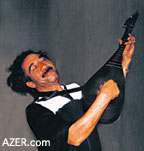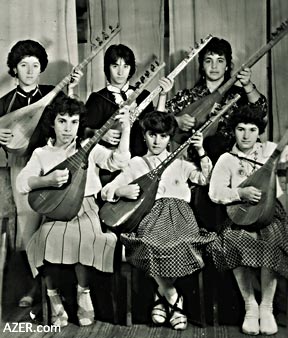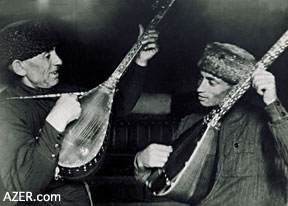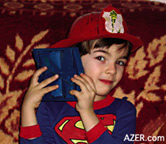|
How do you actually become an ashug? There's a lot more to it than just learning to play the saz and sing a few songs. Ashug art springs from oral traditions that have been transmitted from generation to generation since pre-history, changing and developing as they adapted to new places and times. Music, verse forms, and images of nature from pre-Islamic Azerbaijani lore later mixed with a generous dose of Sufi philosophy to create what is known as the "ashug style" of the 14th-15th centuries. Sufism is a mystical branch of Islam devoted to achieving a loving union with God - thus the name "ashug" whose root means "lover" or "person who is in love". Ashug art is considered to have been at its height in the 17th-18thth centuries when ashugs traveled and performed throughout the Caucasus for both khans and common folk alike. During the 19th century, ashug songs took on an aspect of social enlightenment and protest against injustice. During the 20th century, although the Soviet state attempted to harness the art for its own propaganda, ashugs remained true to their roots and carefully preserved their traditions. Today's ashugs actively keep this heritage alive and are continuing to improvize new songs in ancient forms. Thus, becoming an ashug means to immerse oneself in centuries of tradition. Ashug art has its own history, philosophy and classic canon. Being an ashug also implies adopting a certain way of life. An ashug is expected to be of a high moral character, to speak the truth even when it is dangerous, and to be an advocate for the people.  Ashug performance is often described as syncretic, meaning that it combines so many aspects including saz playing, singing in several different styles, dramatic performance, dancing, improvising, and storytelling. In addition, ashug performances should begin with prayers and special verses known as "ustadname" (meaning, "words of the master") meant to set apart and identify the performance that follows as one of sacredness or holiness. Ashugs know to play certain songs first, certain songs last, and to treat their saz, their elders, and their country with respect. More than a simple performer, the ashug is the inheritor of the position of the pre-Islamic shaman or seer. He is perceived as a healer and protector of the people. How is such a complex art passed down from generation to generation? Most ashugs begin in childhood, learning first from a relative or a neighbor. Young people sometimes study saz at a local music school or "tekhnikum" which is like a performing arts school. Ashug course Ashug Ulduz Sonmaz (another original member of Ashug Pari Majlisi) has developed a four-year ashug course for tekhnikum students. It covers such diverse areas as folklore, literature, history, music, versification as well as performance. Serious learners usually apprentice themselves to an "ustad", or master, with whom they study for several years. Over time, ashugs may have more than one master as they continually seek to deepen and enrichen the complexity of their performance. The process of learning is considered to be a life-long process. I have often seen ashugs of all ages gather to play together and learn from each other. Some even choose to get a degree in Ashug Art at Azerbaijan State Culture and Arts University, which offers courses in all aspects of the tradition under the direction of Folklorist Maharram Gasimli. Play the Saz  One of the first things that an aspiring ashug must master is learning to play the saz. This instrument is a descendent of the instrument known as "gopuz" which was played by Dada Gorgud (an epic that is believed to date back in oral tradition to about the 6th or 7th century). The Azerbaijani saz is an instrument with 8 or 9 strings. It belongs to the lute family and is made of mulberry wood. The strings of the saz have a mellow metallic sound, which, when played expertly, can best be described as resembling the sound of waters of a rushing mountain river. When listening to the saz, watch how the melody develops along the higher strings, while the lower strings provide accompaniment of harmonies and overtones. Notice how the melodies develop, change, and then circle back to their origin. Most ashug music features vocals, which are echoed and answered by the instrumental saz phrasing. Also note the driving rhythms said to be inspired by the hoof beats of the horses ridden by nomadic ancestors. Ashug vs. Mugham Ashug music is quite different from Western music. Like mugham [pronounced mu-GHAM] - another very famous music tradition in Azerbaijan - it features improvisation within a traditional structure. However, unlike mugham, the roots of the ashug art are folkloric rather than classical and they stem from oral, rather than written tradition. While mugham is considered an urban art, ashug music is considered a rural art (although it is also associated with certain urban centers such as Tabriz), and still today is very popular in the regions of Azerbaijan where distinctive regional "schools" (such as Shirvan, Gadabay, Karabakh) each has its own style. While mugham performers sing "gazals" (a classical written verse form originally derived from Iranian and Arabic meters), ashugs sing poems written in traditional Turkic syllabic verse. Mugham music features improvised, non-rhythmic passages with short rhythmic episodes, while ashug music is mostly rhythmic with short improvised passages. Ashug forms such as "deyishma" (pronounced de-yish-MA), which are poetry competitions, showcase verbal dexterity and ability to improvise lyrics, which is not a feature of mugham. While mugham is played in a trio ensemble [accompanied by gaval and kamancha], the most traditional form of ashug music is played solo. However, the genres are not mutually exclusive - mugham singers can have ashug songs in their repertoire, and ashugs from certain regions also use mugham style improvisation in their performances. Ashug music  The modal scales used with ashug music are the same as those used in mugham, and like much Azerbaijani folk music they often feature the mode "Shur" (a mode built upon three chained tetrachords - four note blocks - with the intervals 1-1/2-1). Shur is often viewed as producing sad emotions. Left: Ashug Mirza Bayramov is playing saz with his student Gaimar Isgandar. Courtesy: Azad Ozan Karimli. More than a scale, these modes feature a dominant tonic note to which the music always returns after digressing. A hava is built of a number of sections, which can be played in their most simple form or elaborated and developed for many minutes. A skilled ashug will often repeat the same sections several times with even more complex variations, requiring increasingly tricky fingerwork. Learning the saz to this degree of mastery takes many years. A hava can last from five to ten minutes or longer, depending upon how much the ashug is able to develop the various themes and variations. Thus, although many hava date back hundreds of years, in performance there is always something new and spontaneous. Azerbaijani audiences can recognize many hava and they enjoy listening for subtle variations in the performance. Havas are said to evoke a wide variety of moods, including joyous, heroic, romantic, tragic or philosophical emotions, and the artistic possibilities become more complex with the addition of lyrics. An ashug is expected to have mastered at least 50 hava, and a master ashug is likely to know more than 70. The words sung to a hava are not fixed, and the way a given hava can be combined with different lyrics is an art in itself. The lyrics of ashug songs are poems written in traditional verse forms (such as the 8-syllable "garayli" and the 11-syllable "goshma"), which have a variety of meters and rhymes. Some of the meters have extremely intricate rhyme schemes and demand the use of homonyms and double meanings. The meter of the poem has to match the musical rhythm of the hava. A professional ashug should have memorized a minimum of 500 works of classic ashug poetry, including works of all of the major ashugs from the 15th-20th century. Ashugs also must master several vocal styles - for singing, reciting, and narrating. Large Repertoire But that's not all. An ashug is not expected to simply memorize huge quantities of verse - he or she should also be able to spontaneously compose new verse in any of the traditional rhymes and meters. The ability to improvise poetry is tested in competitions called "deyishma," in which two ashugs try to outwit one another. The first ashug proposes a topic or poses a riddle in verse, and the second one must respond or answer using the same poetic meter. Ashugs also write their own verses, or use verses of contemporary "el shairi" or folk poets in their lyrics. In this way, the art comments on contemporary life as well as preserves the past. Another form of ashug art is the telling of "dastans" (pronounced das-TANS) or oral epics. Not all ashugs are "dastanchi," (pronounced das-tan-CHI) or dastan - performing ashugs. The performance of a dastan is extremely complex and is considered the highest form of ashug art. Telling a dastan requires learning a special type of dramatic epic recitation, which combines storytelling with singing, playing, dancing and acting. An ashug is expected to act out the parts, tell the story in an entertaining fashion, convincingly presenting both comic and tragic events, and adding improvised commentary relevant to the audience. Classical dastan, such as Koroghlu (pronounced ko-rogh-LU), the famous legend of the "Son of a Blind Man" can last for 9 or 10 hours (stretched over several days in three-hour sessions). It can contain hundreds of poems, which must be memorized and played to a variety of hava. Twentieth century dastans are considerably shorter. Although classical dastans are not told as often as they used to be prior to the advent of television, there are still many dastanchi ashugs in Azerbaijan, and classic dastans are still being taught to the younger generation. Fireman and ashug So, could Atilla really become a fireman AND an ashug? The answer is yes. Although ashugs have always been considered to be professionals, like most artists, only a few can actually make their living by it, and most of them have other jobs. Furthermore, it is a serious error to consider these folklore practitioners unlettered "folk." We have met ashugs of all classes and professions, and many have advanced degrees, often in literature or the arts. Isgandar Usta [Master Isgandar] who made our saz, is also a helicopter pilot and a science professor. Ashugs live in the modern world just like the rest of us, facing the same problems and stresses that we all share. What makes them special is that they are able to transform their challenges into an art form, which reveals Azerbaijan to itself at its most beautiful. The ashug's performances are intended to inspire their fellow man to believe in themselves and believe in their future. Could Atilla really become an ashug if he wanted to? With mastery of the Azerbaijani language and several years of study, yes. Azerbaijanis are always willing to share their culture, to explain it, to teach it. Ashug art has a delicacy and a philosophical depth that is a unique contribution to the heritage of humanity, and for those who spend the time to learn it, it will, indeed, provide a lifetime of spiritual and intellectual riches. It's obvious that Atilla likes listening to some ashugs more than others. And still on occasion, he covers his ears. Nor can he always sit through lengthy concerts. Of course, he may not, in fact, become "the first AzerbaijaniAmerican ashug-fireman ever", but it is my hope that when he grows older, something of this experience this year in Azerbaijan will remain with him - the special sound of the saz, the cadences of the Azerbaijani songs, the memory of these special people who play and sing this ancient music. And it is my belief that these memories will add a depth and beauty to his inner life that he could never have gotten anywhere else. Indeed, it's not always so easy to mix parenting and overseas research, but I'm counting on it being worth it all in the long run. Back to Index AI 12.4 (Winter 2004) AI Home | Search | Magazine Choice | Topics | AI Store | Contact us Other Web sites created by Azerbaijan International AZgallery.org | AZERI.org | HAJIBEYOV.com |







